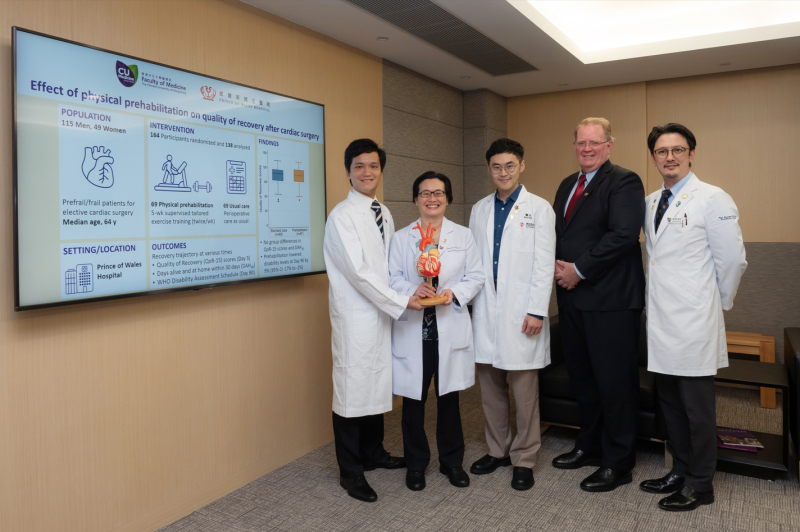Physical prehabilitation beneficial for prefrail/frail patients’ recovery after cardiac surgery




 From left: Dr Derek Yau, Prof Anne Lee, Dr Man-Kin Wong, Prof Gavin Joynt, Prof Randolph Wong
From left: Dr Derek Yau, Prof Anne Lee, Dr Man-Kin Wong, Prof Gavin Joynt, Prof Randolph WongVulnerable or frail patients who received physical prehabilitation, compared with those who received usual care, had clinically meaningful decrease in disability scores at 90 days after cardiac surgery, a Chinese University of Hong Kong (CUHK) study found.
The first-of-its kind randomized controlled trial (RCT) was conducted between July 2018 and October 2023 to determine the effect of a structured exercise prehabilitation programme on patient-centred outcomes (such as 15-item Quality of Recovery [QoR-15] score, major adverse cardiac and cerebrovascular events [MACCE], days alive at home [DAH30], and WHO Disability Assessment Schedule [WHODAS] 2.0 score) in prefrail and frail patients who underwent cardiac surgery at the Prince of Wales Hospital. Previous cardiac prehabilitation RCTs were conducted mostly in nonfrail patients, such as those who were able to walk >400 m in the 6-minute walk test (6MWT). [Br J Anaesth 2024 Nov 6:S0007-0912(24)00599-3]
Prefrail to moderately frail (Clinical Frailty Scale [CFS] of 4–6, 6MWT distance <400 m) adult patients scheduled to undergo elective cardiac surgery were randomized to receive supervised, structured physical prehabilitation (individualized and tailored exercise training, plus verbal health advice to optimize physical and psychological well-being and to encourage exercise at home) twice weekly (n=69) or standard care only (control; no structured exercise programme or exercise-specific health promotion advice; n=69) for 5 weeks preoperatively. Both arms received standard perioperative care.
Compliance with the 5-week prehabilitation programme was high (full attendance rate, 82.4 percent). The intervention was found to increase functional capacity (6MWT) without adverse exercise-induced events preoperatively, and decrease disability levels by day 90 postoperatively (disability-free survival defined as WHODAS <16 percent, 5.3 vs 14.6 percent; mean difference, -9 percent; 95 percent interval [CI] -17 to -2 percent; p=0.017). However, there were no between-group differences in QoR-15 scores (median difference, -3 percent; 95 percent CI -9 to 3), early and late MACCE, and DAH30 (p=0.779).
“Participants in the prehabilitation group were highly motivated and enjoyed their aerobic and resistance training sessions. The training regimen included activities such as treadmill walking, arm and leg cycling, stepping exercises, and use of weights to strengthen the upper and lower limbs,” reported Dr Derek Yau of the Department of Anaesthesia and Intensive Care, CUHK, first author of the study. “This may explain why these patients were able to walk an average of 22 m further than those in the usual care group during the 6MWT before surgery.”
“There is a widespread misconception that vigorous exercise is unsafe for frail patients with heart conditions before surgery,” noted co-investigator, Professor Anna Lee of the Department of Anaesthesia and Intensive Care, CUHK. “Our findings support the safety and effectiveness of cardiac physical prehabilitation for vulnerable to moderately frail patients when conducted under the careful supervision of a physiotherapist. We urge hospital administrators to allocate more resources toward implementing physical prehabilitation programmes before cardiac surgery to enhance patient outcomes in the future,” she concluded.